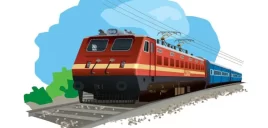Three-phase AC locos such as WAP-5 use some fairly new technology as compared to the earlier generations of diesel-electrics and electrics. In most of the earlier locos, the traction motors driving the axles are DC motors. DC motors were used because they afforded (in those days) far superior speed and torque control compared to AC motors — the latter require variation of input frequency and voltage for effective control, which was not an easy matter earlier.
Modern microprocessor technology and the availability of efficient and compact power components have changed that picture. In 3-phase AC locos, the input (single-phase AC) from the OHE is rectified and then 3-phase AC is generated from it, whose voltage, phase, and frequency can be manipulated widely, without regard to the voltage, phase, frequency of the input power from the OHE. AC traction motors can thus be driven with a great degree of control over a wide range of speed and torque.
AC traction motors are also used on diesel-electrics nowadays. The WDP4 & WDG4 are examples of this.
Details: There are 3 main stages in the power circuit of a 3-phase AC loco.
Input Converter : This rectifies the AC from the catenary to a specified DC voltage using GTO (gate turn-off) thyristors. A transformer section steps down the voltage from the 25kV input. It has filters and circuitry to provide a fairly smooth (ripple-free) and stable DC output, at the same time attempting to ensure that a good power factor presented to the electric supply. There may also be additional mechanisms such as transformers, inductors, or capacitor assemblies to improve the power factor further.
The transformer section is designed with high leakage impedance and other characteristics, which together with the fine control possible with the GTO switching, allow the loco to present nearly unity power factor, a very desirable situation from the point of view of the electricity suppliers (the grid). The main transformer also has some filter windings which are designed to further attenuate harmonics from the loco’s traction motors which may pass through the filtering in the DC link.
The input converters can be configured to present different power factors (lagging or leading) to the power supply, as desired. IR’s WAP-5 and other 3-phase AC locos are generally configured to present a unity power factor (UPF). (Note: the power factor cannot be changed on the run.)
DC Link : This is essentially a bank of capacitors and inductors, or active filter circuitry, to further smooth the DC from the previous stage, and also to trap harmonics generated by the drive converter and traction motors. Since the traction motors and drive converters present non-linear loads, they generate reactive power in the form of undesirable harmonics; the DC link acts as a reservoir for the reactive power so that the OHE supply itself is not affected.
During regenerative braking this section also has to transfer power back to the input converter to be fed back to the catenary. The capacitor bank in this section can also provide a small amount of reserve power in transient situations (e.g., pantograph bounce) if needed by the traction motors.
Drive Converter : This is basically an inverter which consists of three thyristor-based components that switch on and off at precise times under the control of a microprocessor (pulse-width modulation). The three components produce 3 phases of AC (120 degrees out of phase with one another). Additional circuitry shapes the waveforms so that they are suitable for feeding to the traction motors. The microprocessor controller can vary the switching of the thyristors and thereby produce AC of a wide range of frequencies and voltages and at any phase relationship with respect to the traction motors. Various kinds of thyristor devices are used to perform the switching.
Currently produced modern locos generally use GTO thyristors (Gate Turn-Off thyristors), but it is expected that soon insulated-gate bipolar transistors (IGBTs), which offer extremely high switching speeds allowing for finer control over the waveforms generated, will be the switching technology of choice. The WAP-5, WAP-7, WAG-9, and WAG-9H models all use GTOs. At present [5/02], no Indian loco uses IGBTs; some trial locos such as the 12X from Adtranz do use this technology, as do many light-rail and metro locomotives or EMUs around the world. [5/02] The new AC-DC EMUs in the Mumbai area (introduced on WR) use IGBTs.
The 3-phase AC is fed to the AC traction motors, which are induction motors. As the voltage and the frequency can be modified easily, the motors can be driven with fine control over their speed and torque. By making the slip frequency of the motors negative (i.e., generated AC is ‘behind’ the rotors of the motors), the motors act as generators and feed energy back to the OHE — this is how regenerative braking is performed. There are various modes of operation of the motors, including constant torque and constant power modes, balancing speed mode, etc. depending on whether their input voltage is changed, or the input frequency, or both.
AC motors have numerous advantages over DC motors. DC motors use commutators which are prone to failure because of vibration and shock, and which also result in a lot of sparking and corrosion. Induction AC motors do not use commutators at all. It is hard to use a DC motor for regenerative braking, and the extra switchgear for this adds to the bulk and complexity of the loco. AC motors can fairly easily be used to generate power during regenerative braking. In addition, DC motors tend to draw power from the OHE poorly, with a bad power factor and injecting a lot of undesirable harmonics into the power system. AC motors suffer less from these problems, and in addition have the advantage of a simpler construction.
Source – IFRCA.org
This entry was posted in 2 Railway Employee, STUDY NEW, Railway Employee











